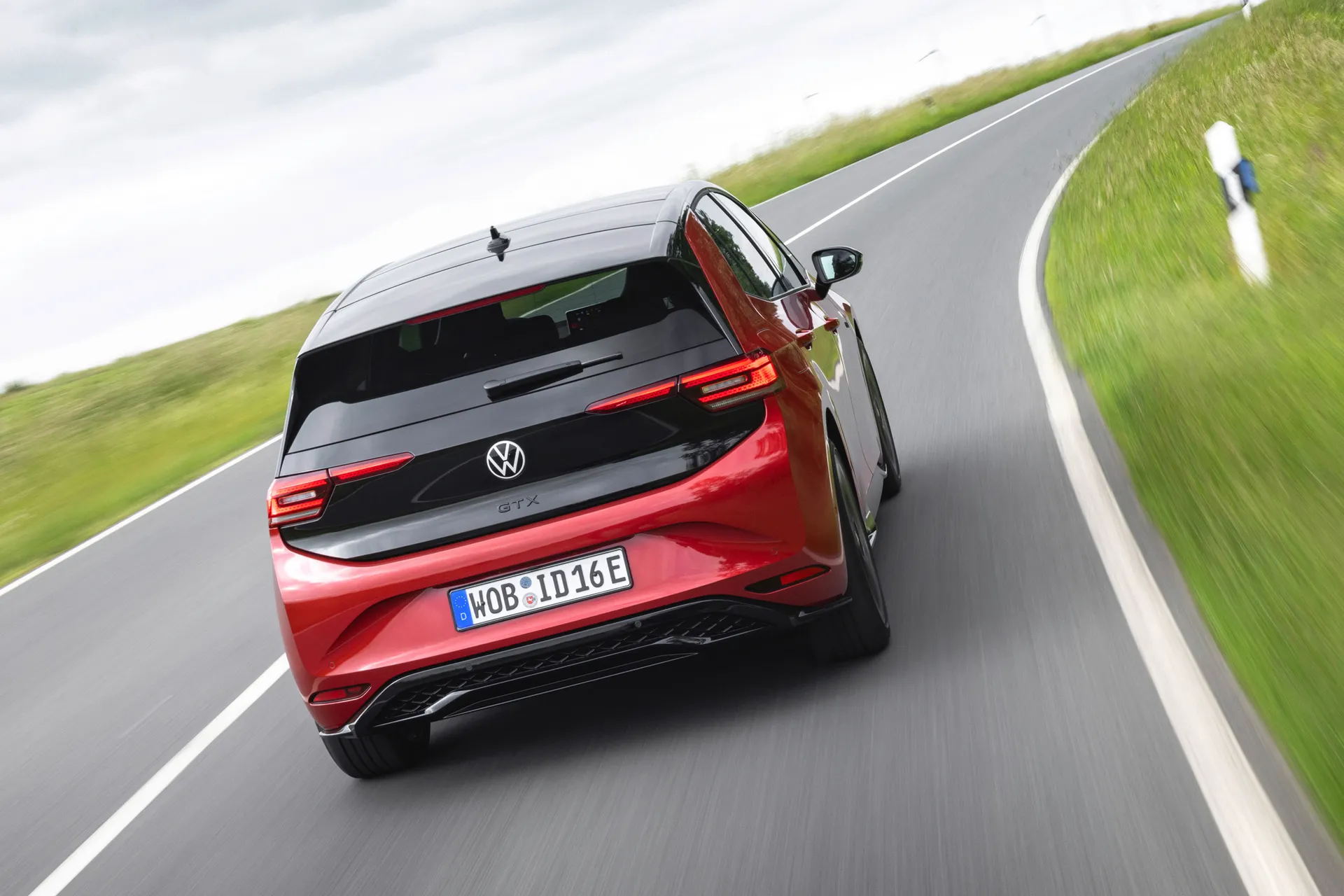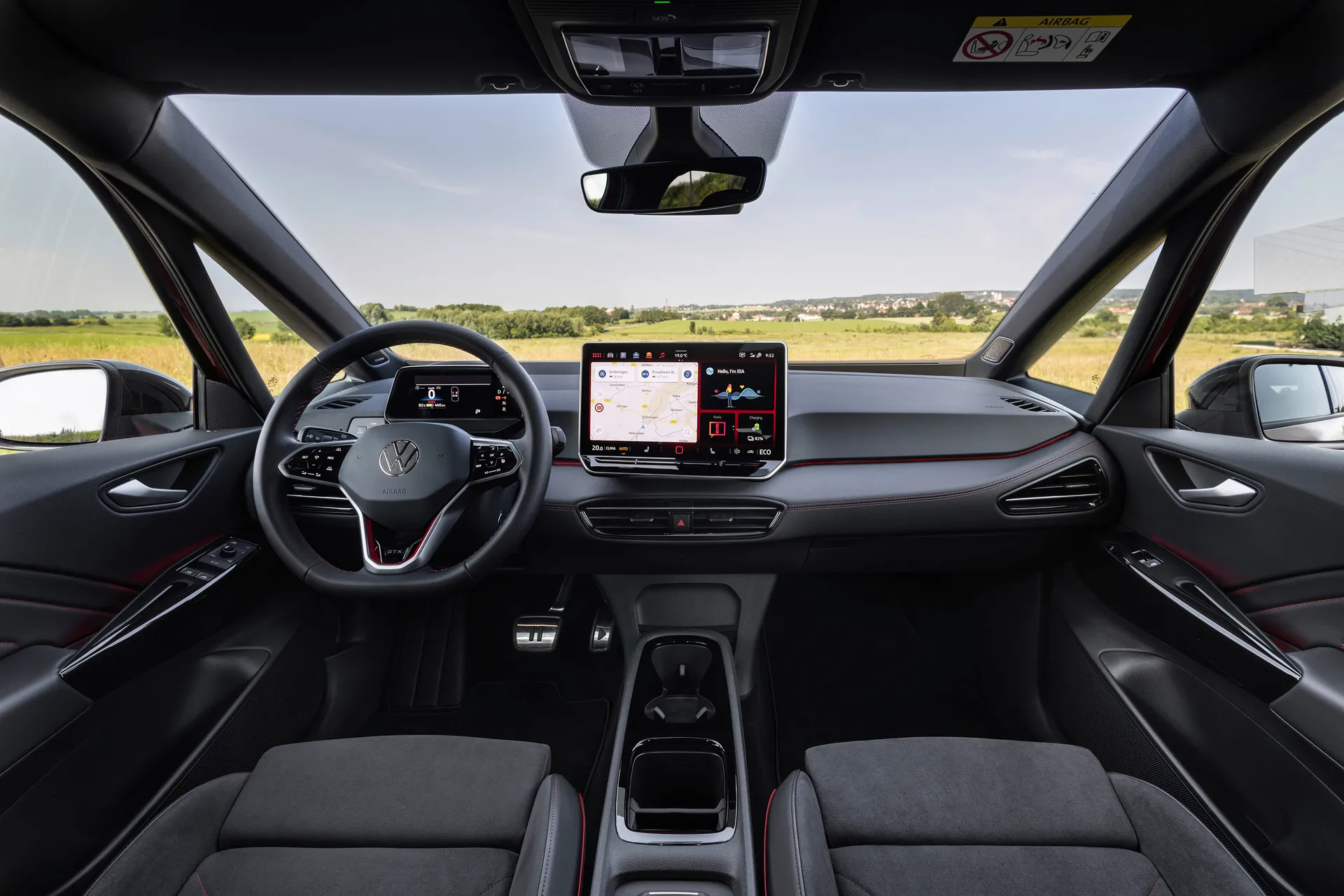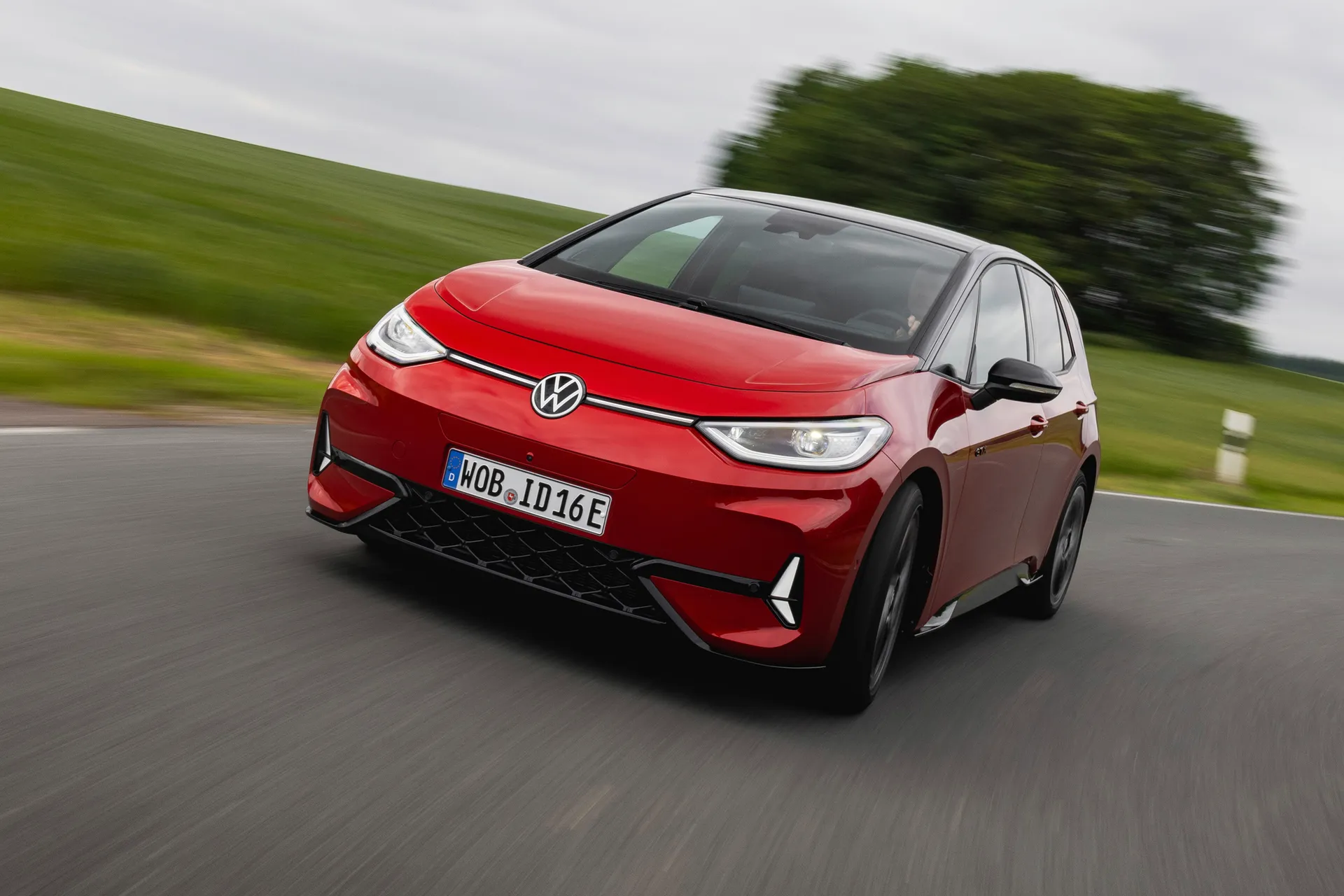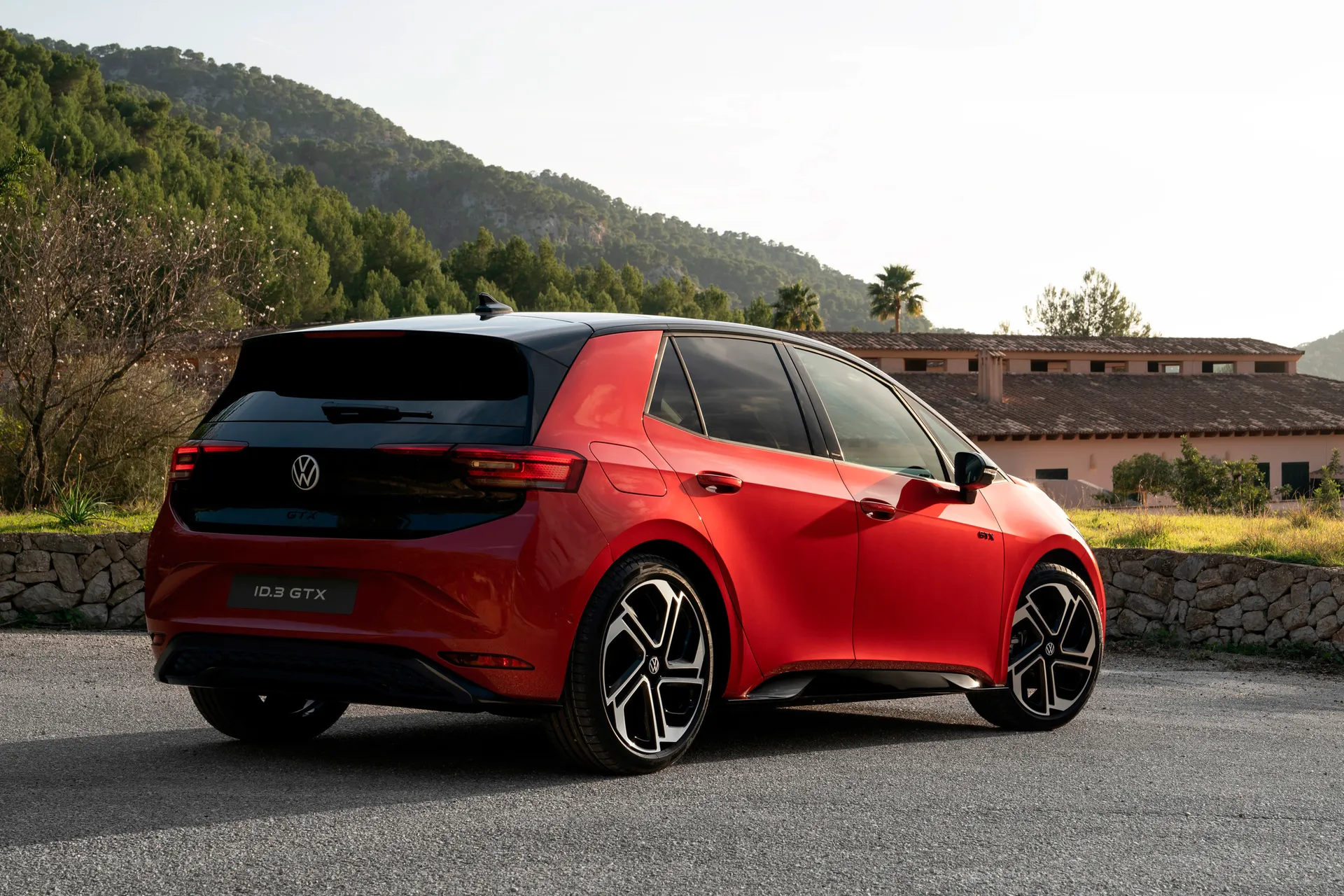Volkswagen ID.3 GTX Review 2025: Price, specs & boot space
Written by Matt Robinson
- 2024
- Family hatch
- EV
Quick overview
Pros
- Decent straight-line performance
- Efficient powertrain
- Same updated cabin as rest of ID.3 range
Cons
- Not really that fun to drive
- Frustrating switchgear choices
- Aggressive lane assistance
Verdict: Is the Volkswagen ID.3 GTX a good car?
"The Volkswagen ID.3 GTX is quick and capable, but as a performance car, it'll leave you a bit wanting. There are more fun EVs that cost less, and similarly priced petrol hot hatches are way more entertaining."

It's not particularly difficult to make an electric car go fast. Putting a more powerful motor into an EV is much easier than shoe-horning in a big engine or adding a massive turbocharger (or two) and all the associated work, and so, we see all sorts of models that aren't really intended as out-and-out performance cars despite being able to out-drag the average petrol hot hatch.
If you are to slap a performance badge onto an EV, then, it needs to offer something beyond just straight-line performance. The Abarth 600e, for instance, has a surprisingly scrappy, unrefined attitude, much like a petrol-powered Abarth, with the pure numbers becoming less important. But how about the Volkswagen ID.3 GTX?
From the GTX badging alone, you can't help but feel there's a lack of commitment. It doesn't have a GTI or R badge, as though it doesn't need to live up to the excitement of models using such monikers. And that doesn't seem to be lost on VW, which is set to ditch GTX and use its more traditional labels for future products like the production version of the excellent-looking ID GTI concept.
That's a little way off, so for now, we have cars like the ID.3 GTX and ID.7 GTX, which feel more like trim grades than special models in the range. Yes, the ID.3 GTX is quick and capable considering its rear-wheel drive layout, but it never feels that thrilling, so our recommendation is to save a bit of money and go a rung or two down the ID.3 ladder.
Doing so does result in a significant drop in performance, though. The GTX is by far the fastest member of the ID.3 family, offering 326PS for a 0-62mph time of 5.7 seconds. Despite this performance, it remains very efficient, offering up to 369 miles on a full charge. And for once, it is possible to get relatively close to that number.
Meanwhile, changes across the ID.3 range have made the car much better, especially in terms of the infotainment system, which was one of the real bugbears of the pre-facelift car. Some annoyances still remain, of course, including the electric window controls and the steering wheel touchpads, but it's good to see that VW is moving away from these designs in more recent additions to the range.
Looking for a used car for sale? We've got 100s of Volkswagen Approved Used Cars for Sale for you to choose from, including a wide range of Volkswagen ID.3s for sale.
Is the Volkswagen ID.3 GTX right for you?
If you're after a true EV performance car, probably not. The ID.3 GTX is quick, but not especially exciting or engaging. For that, we'd look elsewhere, but if you merely want an effortlessly fast and well-equipped family EV, the GTX makes more sense.
What’s the best Volkswagen ID.3 GTX model/engine to choose?
Some countries are given the choice of an entry-level ID.3 GTX and a more powerful GTX Performance, but things are kept simpler in the UK, with only the latter offered. Making things even easier, there's only one size of battery available.
What other cars are similar to the Volkswagen ID.3 GTX?
The most similar is the Cupra Born VZ, which uses the same platform and 326PS motor, although it's actually a tenth quicker from 0-62mph. It's a bit cheaper than the ID.3 GTX, and despite using many of the same parts, a little bit more fun.
The MG4 XPower is cheaper still and considerably more powerful than both, but it struggles with its output and doesn't feel as well made. Somewhere between the two is the Abarth 600e, which is more modest in terms of power, but arguably more entertaining than any of them.
The ID.3 GTX's starting price will also get you into a petrol-powered hot hatch, including VW's own Golf R.
Comfort and design: Volkswagen ID.3 GTX interior
"The GTX doesn't do a great deal to differentiate itself from other ID.3 models on the inside. On the plus side, it benefits from range-wide updates, including a better infotainment system, which goes some way to offset the annoyances that have remained."

Other than badging, there's not much going on inside the GTX to let you know you're in what's supposed to be a more special version of the ID.3. Also, with the light grey trim option of other ID.3s removed, it ends up being a bit of a sombre space.
It's comfortable, though, and we've always been a fan of the unusual windscreen layout, which appears to be placed quite far from the driver and braced by a split A-pillar design. It makes for good forward visibility and a feeling of airiness.
The cabin is generally pretty spacious, helped by the use of a bespoke EV platform with a flat floor. It scores well in terms of comfort, too, with a supportive set of front seats.
Where all versions of the ID.3 let themselves down is in terms of the switchgear. The touch-sensitive button pads on the steering wheel are similar to what was originally used in the eighth-generation Volkswagen Golf but scrubbed from most versions following a facelift, but sadly, they're still in the ID.3.
The problem is that without properly defined individual buttons, you end up pressing the wrong thing quite frequently, for instance, turning down the audio volume instead of reducing the cruise control speed. It doesn't help that some functions can be activated by swipes as well as pushes.
Even worse is the electric window switches on the driver's side. There's just one pair to control all four, with a touch-sensitive button marked 'REAR' to switch between. As it's touch sensitive, it takes a particular amount of pressure to activate, so you can never be sure without taking your eyes off the road. And you're almost guaranteed to accidentally open a rear window at some point.
As if all that wasn't enough, that same part features an electric window control which infinitely rotates to select each mirror or the heating and folding functions, rather than a dial which sits in defined points. So, again, you have to take your eyes off the road and look at the thing to see which function is illuminated. Thankfully, this is another item being dropped from other Volkswagen models.
Quality and finish
As the GTX was added to the range after the ID.3's mid-life facelift, it benefits from the model's much-needed quality updates, which added much more in the way of soft-touch surfaces. Before, there was a surprising abundance of cheap plastics. It still doesn't feel solid in the way that Volkswagen products from a decade or so ago used to feel, but it's a step in the right direction.
Infotainment: Touchscreen, USB, nav and stereo in the Volkswagen ID.3 GTX
The ID.3's new 12.9-inch infotainment system provides a noticeable improvement over the bug-prone 10-inch system used before, which pre-dates the arrival of the GTX. Responsiveness to touch is good, and there isn't any excessive lag when switching between different things.
It's annoying having to use it for climate functions, though, particularly when the climate screen doesn't automatically disappear after you're done using it, meaning an extra prod (and the associated distraction from the road) is necessary to bring back up the navigation or whatever menu you were on before. There are shortcuts for temperature on the screen bezel, and these are now backlit, so you can finally see them at night.
The USB provision is good, with a total of four USB-C ports provided – two in the front and two in the rear. Wireless Android Auto and Apple CarPlay and included as standard. The GTX includes an excellent Harman Kardon sound system as standard.
Space and practicality: Volkswagen ID.3 GTX boot space
In terms of practicality, the GTX is no different from other ID.3, and that's to say, very good. Despite being only marginally larger on the outside than a Golf, it feels a lot more spacious inside. Headroom and legroom are decent for rear-seat passengers, and no occupant should feel unduly cramped.
The boot space is OK but far from class-leading at 385 litres, and while you can fit charging cables in the underfloor storage area, you'll need to pack them up just right to avoid the boot floor popping up. If you need to carry larger items, there's a 60:40 split folding rear seat bench opening up 1267 litres of load space. Just bear in mind that the rear bench doesn't fold completely flat.
In terms of storage in the rest of the cabin, there's a massive cubby under the central armrest, a further storage area just in front plus a pair of cupholders, and some decent-sized door bins all round.
Ride quality and handling: What is the Volkswagen ID.3 GTX like to drive?
"The ID.3 GTX is easy, effortless and capable to drive. It's just lacking the kind of sparkle you'd hope for a car with sporting pretensions."

Volkswagen hasn't just given the GTX more power and some sportier styling and then called it a day. It's been given tweaked steering, plus retuned springs and dampers. The thing is, though, it doesn't feel especially different to drive than any other ID.3.
It's quite capable, with plenty of front-end grip and good traction in the dry despite being rear-wheel drive, but even though the latter attribute makes the GTX feel quite playful in the right setting, there's an odd lack of joy most of the time. It's just not as fun or engaging as, say, a Golf GTI.
The adaptive dampers come with no less than 16 settings, although 15 of them feel pretty redundant, as the GTX feels best with the suspension set as soft as possible. It's not like there's much body roll in this setting, and the car feels like it flows much better with undulations in the road surface, while also making much less fuss over speed bumps.
Generally, it's a relaxing, easy car to drive, so long as the lane assistance is behaving itself, or turned off. It's often triggered by things that aren't actual lane markings, like joins in partly resurfaced roads, aggressively adjusting the steering in the process.
What motors and batteries are available in the Volkswagen ID.3 GTX?
There's only one of each – a 326PS motor combined with the ID.3's larger, 79kWh battery pack. At least, that's the case in the UK, because only the Performance version of the ID.3 GTX is sold here. In other countries, it's possible to buy a base model which makes do with 286PS.
We haven't tried that one, but as it is, the Performance often doesn't feel like it offers an abundance of, well, performance. Accelerating from lower speeds and in Sport mode, it does feel reasonably eager, but there are also times when you put your foot down and think, "is that it?"
The problem is that although 326PS sounds like a lot, the ID.3 GTX weighs around two tonnes. And so, the 0-62mph time is 5.7 seconds, which isn't all that impressive when you consider the similarly priced, similarly powerful Golf R from the same Volkswagen forecourt can do it a full second quicker. Yes, all-wheel drive helps there, but so does a kerb weight that's nearly 500kg lower.
Although EVs are capable of delivering their full torque figures instantaneously, many soften the initial response. That's not the case with the GTX, however, with a wickedly sharp throttle response, especially in Sport mode.
Volkswagen ID.3 GTX range: how far can you travel on a charge?
A range of 369 miles on a full charge is impressive. That's according to the official WLTP figure, but it's not as far-fetched as some. We averaged 4.1 miles per kWh during our testing of the ID.3 GTX, despite clocking a lot of motorway miles, something which usually isn't great for EV efficiency. With a more even mix of driving at a warm time of year, you might actually achieve the 4.4 miles per kWh needed to hit the official figures.
Refinement and noise levels
It's especially important for an EV to be well insulated from the outside, as there's no engine noise to help drown out any particularly vocal wind or road noise. Thankfully for the GTX does well for itself in terms of both wind and road noise.
On the latter front, it probably helps that for a performance car, the ID.3 GTX's tyres are fairly narrow, meaning there's not a massive footprint making a huge racket as it contacts the road surface. They're 215mm wide, which is no fatter than the boots fitted to the 20-inch wheels of the Pro S Match and Pro S Essential.
Safety equipment: How safe is the Volkswagen ID.3 GTX?
The Volkswagen ID.3 was awarded the full five stars when crash tested by Euro NCAP in 2020. The GTX is structurally identical, so that rating very much applies here.
You also get all of the usual driving assistance suspects, including autonomous emergency braking, lane assistance, and speed limit recognition. There's also something called Swerve Support, which tweaks the steering as necessary if you're swerving to avoid hitting something.
Upgrading to the Assistance Package Plus with IQ Drive beefs up the safety systems with additions including lane change assistance, remote control parking assistance and an exit warning system.
Volkswagen ID.3 GTX charging times and cost: How much does it cost to charge?
"The ID.3 GTX's 185kW fast-charging capability is fairly average. As the car uses the biggest ID.3 battery available, you'll need to stop for the best part of half an hour for the benchmark 10-80% recharge."

The official figure is 26 minutes, although that is based on optimal conditions. Then again, given that the real-world range of the car is healthy, costly trips to public charging stations should hopefully be a rarity.
On that subject, it'll be just over 10 hours to charge the GTX's battery from near empty to full using a 7.4kW home wallbox, which will cost just under £20 on a typical UK electricity tariff. Some suppliers offer variable rates that are cheaper at certain times of day (usually overnight), which could slash that cost significantly.
Volkswagen ID.3 GTX reliability and warranty
The Volkswagen ID.3 suffered its fair share of software bugs when first released, but these were steadily fixed via over-the-air updates. The facelift brought with it some further upgraded software, too. Volkswagen placed 15th of 33 brands for reliability in the most recent HonestJohn.co.uk Satisfaction Index with a score of just over 90%, and as an electric car, there are far fewer moving parts to potentially go wrong on the ID.3.
The warranty is pretty standard, but also nothing special, lasting three years or 60,000 miles, whichever comes first. The ID.3 also comes with the industry standard eight years/100,000 miles of coverage for the high-voltage battery pack.
Volkswagen ID.3 GTX insurance groups and costs
The ID.3 GTX will likely be more expensive to insure than other ID.3 models. It's in group 34, compared to 27 for the Pro S version of the ID.3, and 19 for the ID.3 Life. Make sure you shop around for the best deal.
VED car tax: What is the annual road tax on a Volkswagen ID.3 GTX?
We have a double dose of bad news on this front. EVs no longer get out of paying for either Vehicle Excise Duty (VED) or the government's premium car tax surcharge. From the second year onwards, you'll need to pay the same £195 annual rate as petrol, diesel and hybrid car drivers, and as the RRP for the GTX is well above the £40,000 threshold, it's an extra £425 annually from years two to six for the premium tax.
Volkswagen ID.3 GTX price
"The GTX is by far the priciest ID.3 at £46,325, but there are significant savings to be had by going for a used or pre-registered example."

Although the standard specification of the ID.3 GTX is very healthy, it's still possible to inflate the price to well over £50,000 by ticking some of the pricey options in the configurator, including the best part of £1000 for red/black two-tone paint and a chunky £2240 for the Assistance Package Plus. It's a bit irksome to see that an energy-saving heat pump is a pricey option on a car with an expensive starting price.
It's possible to pay far less than that by going used, however. Examples with only a few thousand miles on the clock are available for over £10,000 less than the as-new base price, or if you'd rather something fresher, it's possible to get hold of an unused, pre-registered example and save thousands.
To put the RRP in context, the closely related Cupra Born VZ costs £44,635, while the MG4 XPower drastically undercuts each of those at £36,495. An Abarth 600e is slightly more than the MG, but the one you want, the Scorpionissima, is £39,885.
Trim levels and standard equipment
The GTX is, in effect, a single trim level. It's well equipped as standard, coming with 20-inch alloy wheels, matrix LED headlights, ambient lighting, tinted rear windows, a heated leather steering wheel, eight-speaker (plus subwoofer) Harman Kardon sound system, 12.9-inch infotainment system, wireless smartphone charger, electrically folding door mirrors, keyless entry/start, adaptive cruise control, augmented reality head-up display, front and rear parking sensors with a rear-view camera.
Ask the heycar experts: common questions
How powerful is a Volkswagen ID.3 GTX?
What is the range of the Volkswagen ID.3 GTX?
What does Volkswagen GTX mean?
Get our latest advice, news and offers
Keep me updated by email with the latest advice, news and offers from heycar.
By submitting you agree to our privacy policy



